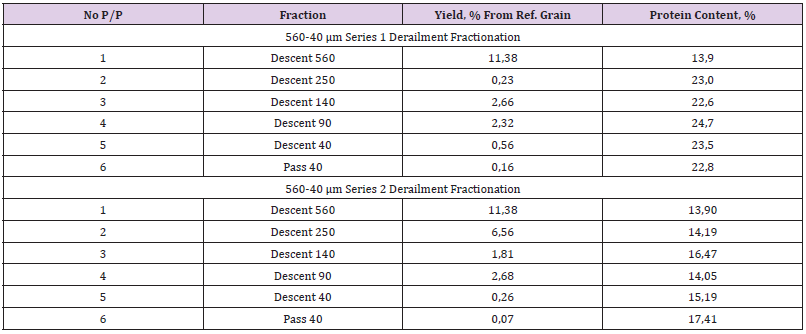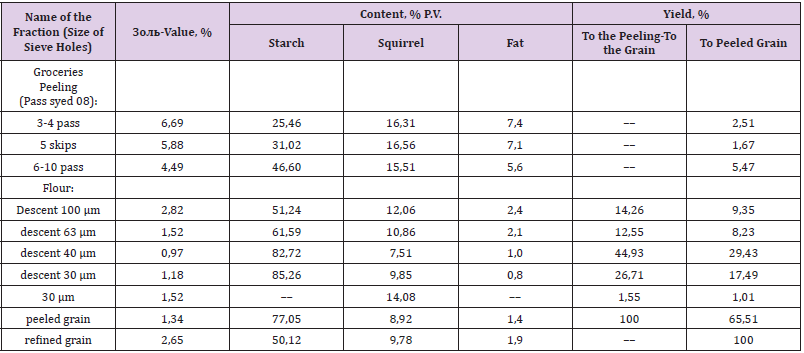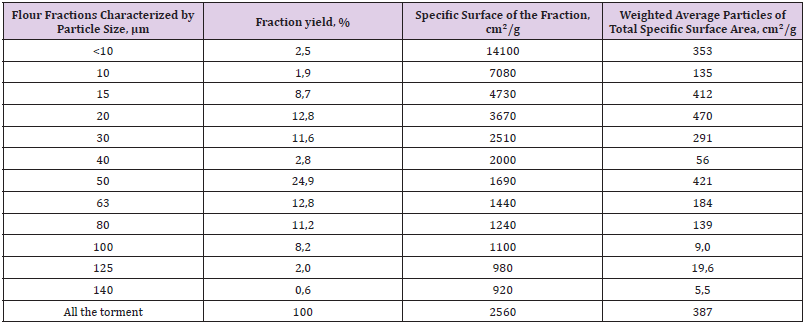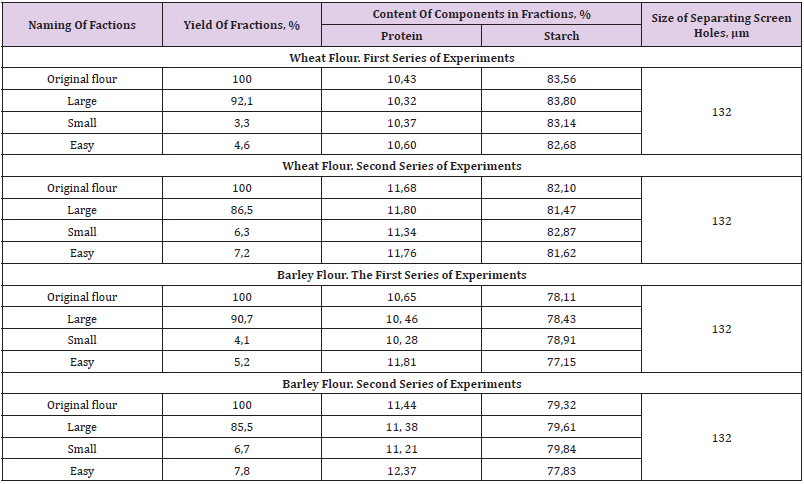Centrifugal Pneumatic-Sieve Fractionation of Barley and Wheat Flour for Maximum Recovery of Protein and Carbohydrate Fractions
Introduction
A feature of the grain farm in Russia is a wide variety of cultivated and processed crops used as raw materials for the production of food products of the population. These crops include both wheat and rye, traditional for the flour milling industry, and cereal crops - buckwheat, rice, barley, oats, millet, etc. The grain of each grain crop is a natural storehouse of the most valuable components necessary for human nutrition: proteins, fats, carbohydrates, vitamins, macroand microelements, minerals, etc. [1-4]. The main goal of mankind during the entire period of its development of grain plant foods was to increase the efficiency of grain use through a more complete use of its natural power, achieved through a deeper separation of cereal grains into anatomical parts. The level of modern development of flour milling technologies makes it possible to extract the endosperm from the grain of the main crops with an efficiency of 90%, the embryo with an efficiency of 25-70% of such crops as wheat and corn, for other crops this process has not been developed. There is no effective process for extracting the aleurone layer from the grains of the crops in question. Although the high value of the protein of this layer is known, it remains inaccessible to human nutrition due to its dense packaging in the fiber layer. Developments have not been completed and therefore there are practically no domestic technologies for extracting protein and starch by the “dry” method from the endosperm of grains of all crops [5-7].
The creation of modern technologies that allow the isolation of individual anatomical parts (endosperm, embryo, aleurone layer, shells) from the grain with the further production of components with a concentrated content of chemical elements (protein, fat, starch, minerals, etc.) from them is the basis of the progressive concept of flour milling production. At the same time, it is necessary to develop technologies for obtaining flour from various crops of a wide range of targeted purposes at the request of consumers, healthy food products. The relevance of the production of such types of flour was due to the high nutritional value of these cereals, their taste and nutritional advantages [8-9]. As a result of solving the problem of effective separation of cereal grains into anatomical parts and their subsequent separation into protein and carbohydrate fractions - flour concentrates, the raw material base of bakery, confectionery, pasta, food concentrate, meat, dairy, canning production will be significantly expanded. For example, barley flour is characterized by a low content of fat, resistant to storage, amino acid composition, not balanced in lysine and threonine, contains mucus that improve the functioning of the gastrointestinal tract. A feature of barley flour is a large amount of polysaccharide (-glucan, which has a cholesterol-lowering effect. Barley flour contains a lot of calcium, phosphorus and iodine [10-12]. The problem is relevant because one of the ways to reduce protein deficiency, improve the quality of nutrition and, as a result, improve human health is to create food products enriched with vegetable protein. Due to their functional features, proteins not only increase the biological value, but also significantly improve the quality of food products, give them dietary and medicinal properties [10-12]. The aim of our research is to develop a technology for separating wheat and barley flour into anatomical parts using pneumatic classification for maximum extraction of protein and carbohydrate fractions.
Objects and Methods of Research
For research, commercial batches of barley and wheat grains were used. Peeling of the original barley grain was carried out on a laboratory peeler of the ZSHN type with a capacity of up to 100 kg / h with a speed of 1500 per minute. The peeled grain was crushed in a laboratory rotary shredder with a passage deck with a hole size of 0.5 mm The circumferential velocity of the grinding rotor was 90 m / s. The crushed product was sifted in a laboratory sieve with an oscillation radius of R = 50 mm and an oscillation frequency of n = 200 rpm on sieves with a hole size of 100, 63, 40 and 30 μm. Centrifugal pneumatic-sieve classification was carried out on a laboratory rotary classifier with a speed of up to 4000 revolutions per minute. The rotary pneumatic classifier consists of the following main parts: a hopper, a vibrating feeder, an apparatus, boxes for collecting products, a filter with a box, a fan and material pipelines. All components of the laboratory unit are combined into three units: a power supply unit consisting of a hopper and a vibrating feeder; apparatus unit, including apparatus and boxes for collecting products; pneumatic transport unit, which includes a fan, filter and material ducts. The frequency of rotation of the rotor was regulated using a frequency regulator. In the process of centrifugal pneumosite vibration separation, the starting product is low-ash light barley and wheat flour, and the components are starch and protein particles, mainly extracted into high-protein or starchy fractions.
Results of the Study
At the first stage of research, modeling of barley grain grinding was carried out according to the developed technological scheme. The scheme includes 5 consecutive stages of peeling barley grain and sorting of peeler sediments. For five passes through the peeler, flower films, fruit and seed membranes, the aleurone layer and the embryo were removed. The yield of peeled barley grain was 65.5%. The braned peeling products were sieved on a sieve with a cell size of 0.8 mm to remove the abrasive particles of the flower films. In the future, it is advisable to grind them to 200-150 μm for use as a food additive in the form of a source of macro- and microelements and components of dietary fiber. The moisture content of barley grain after peeling was 13.2%. In the second stage of research, the peeled barley grain was crushed in a laboratory rotary grinder. The descent from the sieve with a hole size of 100 μm was re-crushed, and then re-sieved on sieves of 100, 63, 40 and 30 μm. As a result of sieving, five fractions of barley flour were obtained. In these fractions, as well as in peeling products, in the grain after purification and in the peeled grain, the protein, starch and fat content was determined. Table 1 shows the fractional composition and protein content in the peeling products of barley grain. As a result of grinding barley grain according to the developed technological scheme, products with the following characteristics were obtained. The grain grinding balance is shown in Table 2.
Table 2 shows that the fractions of barley flour of different sizes differ in protein, starch and fat content. The highest starch content is distinguished by fractions obtained with a sieve with holes of 40 and 30 μm (82.72% and 85.26%, respectively). In larger fractions, the starch content drops sharply (51.24% and 61.59%), which is explained by the presence of shell and protein particles in them. The presence of shells and protein is also reflected in the increase in the ash content of these fractions. The protein content correlates with the ash content of the fractions, with the minimum ash content (0.97%) and the protein content (7.51%) differing in the fraction obtained by passing a sieve with holes of 63 μm and descending from a sieve with holes of 40 μm. The maximum protein content (14.08%) is characterized by the smallest fraction obtained by the passage of a sieve with a hole size of 30 μm. At the same time, the protein content in it is 1.9 times higher than in the fraction with the lowest protein content (7.51%). The fat content decreases with a decrease in the size of the fractions. The largest fraction contains 3 times more fat (2.4%) than the fraction obtained by the descent of a sieve with holes of 30 μm (0.8%). This can be explained by the uneven distribution in the fractions of particles of the embryo rich in fat. The embryo is more plastic than the endosperm and therefore is less susceptible to grinding. As a result, the particles of the embryo mainly fall into larger fractions. This, in part, explains the relatively high protein content (12.06%) in the fraction obtained from the sieve with holes of 100 μm. This fraction also includes particles of the aleurone layer, the cells of which are characterized by a high protein content.
At the third stage of research, centrifugal pneumosite fractionation of barley flour was carried out to isolate starchy, protein and lipid fractions. As a result of modeling the production of carbohydrate components of barley grain by shock grinding and sieve classification, a starchy fraction of barley flour was obtained (sieve convergence with a hole size of 40 μm and 30 μm) with a starch content of 83.7%, which is 6.7% higher than in peeled grain, and 1.67 times higher than in grain after purification. The yield of this fraction was 71.64% to the peeled grain and 46.92% to the grain after purification. At the fourth stage of research, centrifugal pneumosite fractionation of barley flour was carried out to isolate starchy, protein and lipid fractions the basis of the developed method of extracting protein from wheat flour by the “dry” method is the destruction of the protein matrix and the production of its starch-free particles. These particles have dimensions in the range of 0-18 μm. Small (2-9 μm) and medium (10-18 μm) starch grains have the same sizes. Large starch grains have a size of more than 18 μm [8]. As a result of this destruction, it becomes possible to isolate barley protein particles in the process of pneumatic classification, as lighter and smaller.
In standard wheat flour, small particles of protein are relatively small Table 3. This flour is obtained by the roll method of grinding on flour rolling rolls with a diameter of 250 mm, with an intervalian clearance of 10-20 μm and a ratio of 1: 1.25 speeds of fastrotating and slow-rotating rollers. The roughness of the grinding rollers is 2.5-4.0 μm. It is possible to increase the concentration of free small protein particles by grinding standard flour by the impact-abrasion method in disintegrators, by the impact method in the entoleitors or by the roll method in roller machines. The effectiveness of the impact-abrasion method. Table 3 presents data on the granulometric composition of the initial (control) sample of wheat flour of the highest grade and samples of flour crushed on an experimental disintegration machine to varying degrees of dispersion. This degree of dispersion was characterized by the specific surface area of the sample, determined on the PSKh-4 device. Table 4 presents the data of experimental studies on the specific surface of 10 fractions of wheat flour of different sizes.
Table 3: Granulometric composition and specific surface area of samples of starting and crushed wheat flour.
At the final stage, the study of the process of centrifugal pneumosite separation of wheat flour was carried out in two versions. In the developed technology for the production of wheat protein concentrates, this process can be used in one of these variants. In the first version, in this process, it is proposed to obtain such a fraction of free protein particles in which its content in accordance with the task should be 1.5-2.0 times greater than in the original wheat flour. In the second embodiment, it is first intended to obtain a fraction into which all free protein particles are extracted, together with small starch grains, and then divide them into fractions with the greatest possible efficiency of protein extraction into one of these fractions on a centrifugal-axial rotary pneumatic classifier. They were carried out at the pilot plant of centrifugal pneumosite separation of flour, dunst and cereal mixtures. In the experiments, the following parameters of the pilot installation were adopted: the diameter of the body is 200 mm, the diameters of the screen and the mesh cylinder are 200 and 150 mm, respectively. The first series of experiments was conducted to determine the effect of the size of the holes of the separating screen on the output and quality of the fractions. The sizes of the holes of the separating screen varied in the range of 118-315 μm. Metal-woven sieves were used as a separating screen. According to the results of the experiment, the size of the holes of 132 μm was adopted, which provides the yield of the passing fraction of 15% of the initial amount of native baking flour received for processing.
The second series of experiments was carried out to determine the effect of air flow and the speed of the air mixture at the entrance to the sieve cylinder of the apparatus on the efficiency of the fractionation process. Based on the results of this series of experiments, an air mode was chosen, in which the amount of the light fraction does not exceed 8%, and the small fraction 7%. The summarized results of the two series of experiments are presented in Table 5. As can be seen from Table 5, regardless of the size of the flour fractions in wheat flour, the starch content is higher by 3-4% than in the fractions of barley flour, and the protein content of the fractions of wheat and barley flour are practically comparable.
Findings
a) To obtain a concentrated protein fraction, it is advisable to carry out centrifugal pneumosite fractionation of crushed wheat flour, extracting small (up to 18 μm) light particles of protein and starch into one fraction, the yield of which should not exceed 15%.
b) The final separation of protein and starch particles should be carried out on the basis of the difference in their density in the centrifugal-axial rotary pneumatic classifier.
c) The highest starch content is distinguished by fractions obtained with a sieve with holes of 40 and 30 μm (82.72% and 85.26%, respectively). In larger fractions, the starch content drops sharply (51.24% and 61.59%), which is explained by the presence of shell and protein particles in them. The presence of shells and protein is also reflected in the increase in the ash content of these fractions.
d) The protein content correlates with the ash content of the fractions, with the minimum ash content (0.97%) and the protein content (7.51%) differing in the fraction obtained by passing a sieve with holes of 63 μm and descending from a sieve with holes of 40 μm. The maximum protein content (14.08%) is characterized by the smallest fraction obtained by the passage of a sieve with a hole size of 30 μm. At the same time, the protein content in it is 1.9 times higher than in the fraction with the lowest protein content (7.51%).







No comments:
Post a Comment
Note: Only a member of this blog may post a comment.